Hormonal Control of Reproduction: Structure, Function, and Conception
VerifiedAdded on 2023/06/10
|15
|3915
|401
Report
AI Summary
This report provides a detailed analysis of the hormonal control of reproduction in humans. It begins with an overview of the male and female reproductive systems, describing the structure and function of each component, including the penis, scrotum, testicles, ovaries, uterus, and fallopian tubes. The report explains the roles of key hormones like FSH, LH, testosterone, estrogen, and progesterone in gamete development (spermatogenesis and oogenesis) and the processes of conception, including fertilization, implantation, and the menstrual cycle. It also explores how the development of the male and female reproductive systems can affect reproductive health, and discusses methods for preventing and promoting conception. Diagrams are used to illustrate anatomical structures and hormonal processes. The report highlights the interplay of hormones in regulating the reproductive cycle and emphasizes the importance of these hormones in fertility and overall reproductive health.
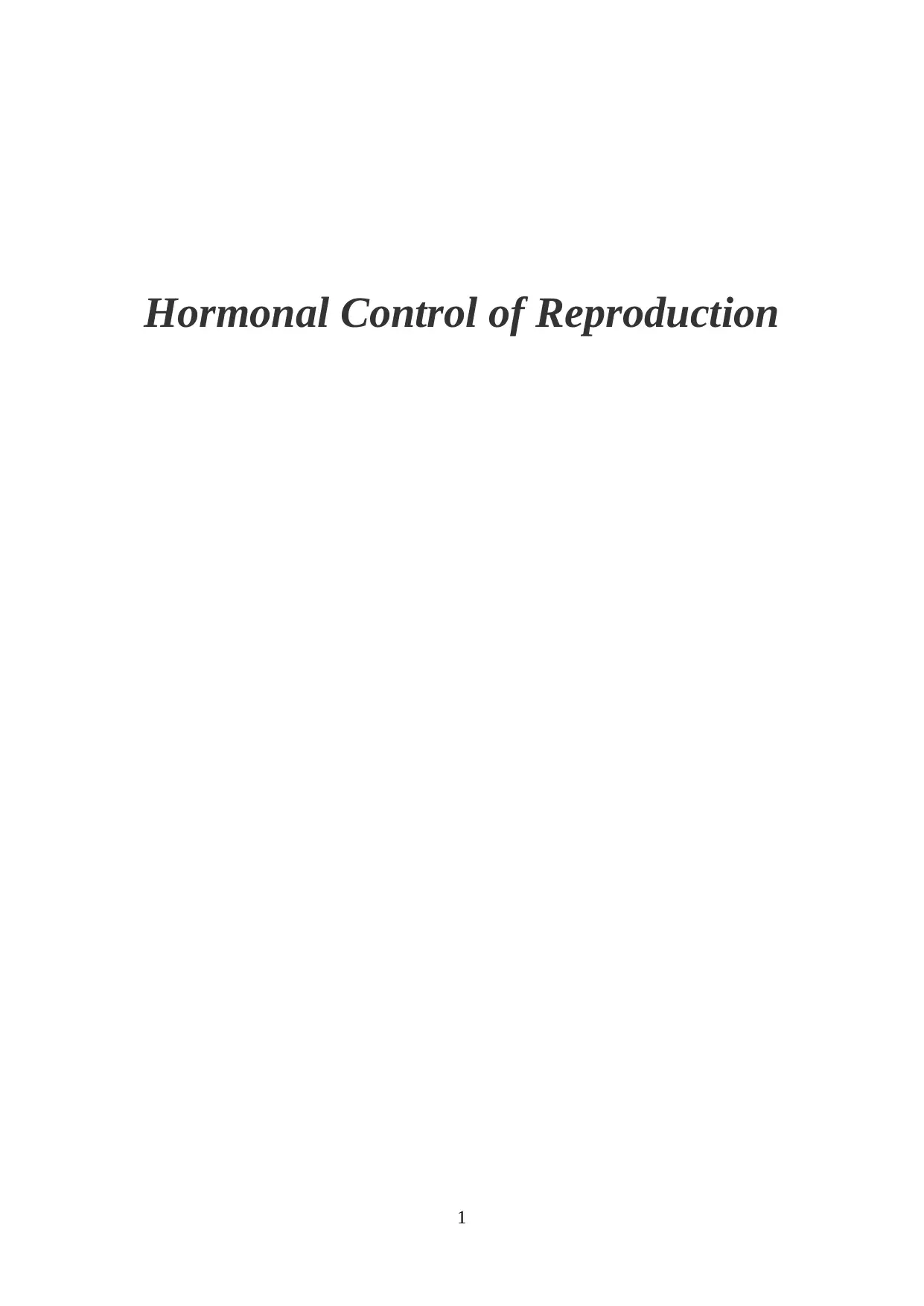
Hormonal Control of Reproduction
1
1
Paraphrase This Document
Need a fresh take? Get an instant paraphrase of this document with our AI Paraphraser
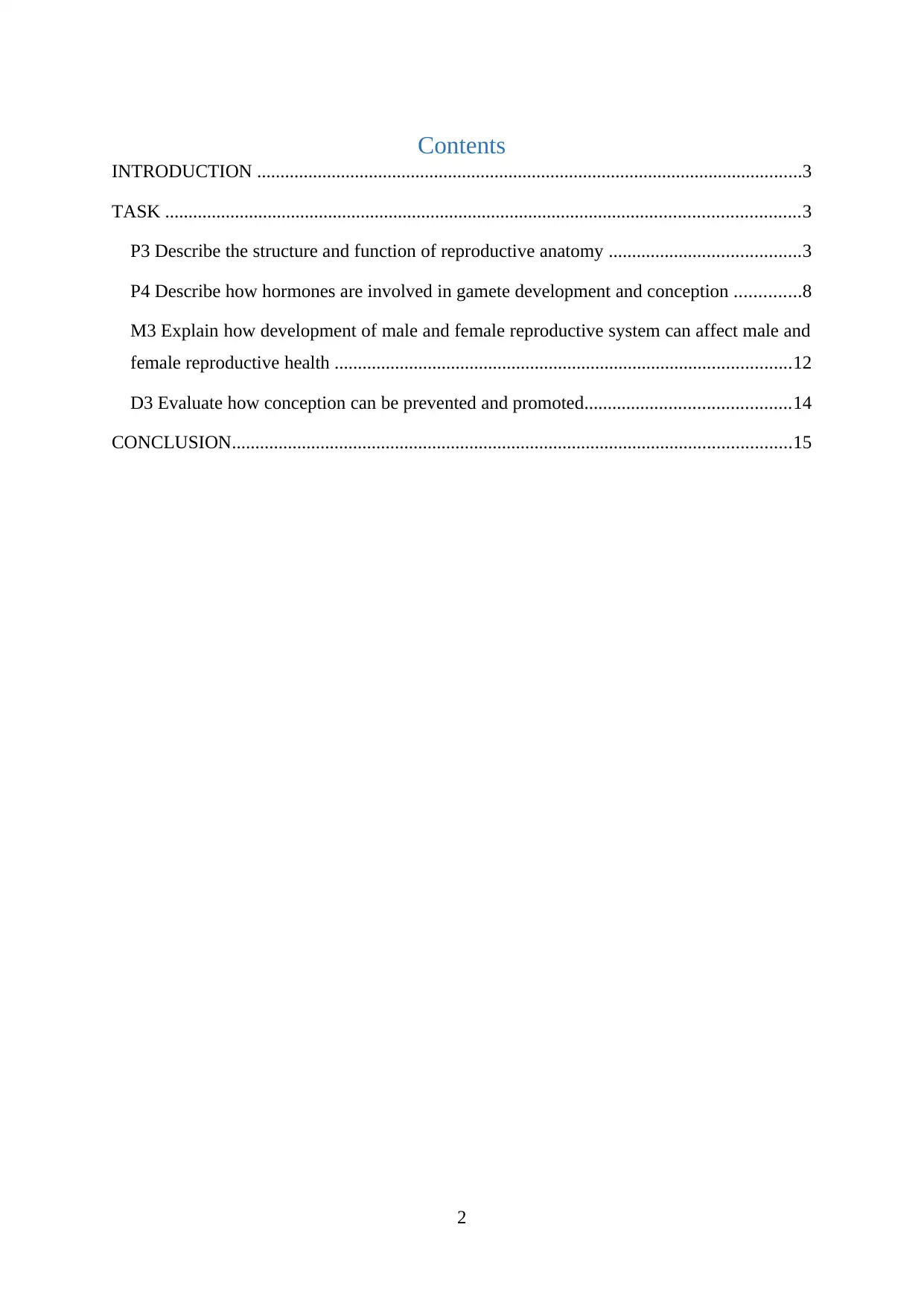
Contents
INTRODUCTION .....................................................................................................................3
TASK ........................................................................................................................................3
P3 Describe the structure and function of reproductive anatomy .........................................3
P4 Describe how hormones are involved in gamete development and conception ..............8
M3 Explain how development of male and female reproductive system can affect male and
female reproductive health ..................................................................................................12
D3 Evaluate how conception can be prevented and promoted............................................14
CONCLUSION........................................................................................................................15
2
INTRODUCTION .....................................................................................................................3
TASK ........................................................................................................................................3
P3 Describe the structure and function of reproductive anatomy .........................................3
P4 Describe how hormones are involved in gamete development and conception ..............8
M3 Explain how development of male and female reproductive system can affect male and
female reproductive health ..................................................................................................12
D3 Evaluate how conception can be prevented and promoted............................................14
CONCLUSION........................................................................................................................15
2
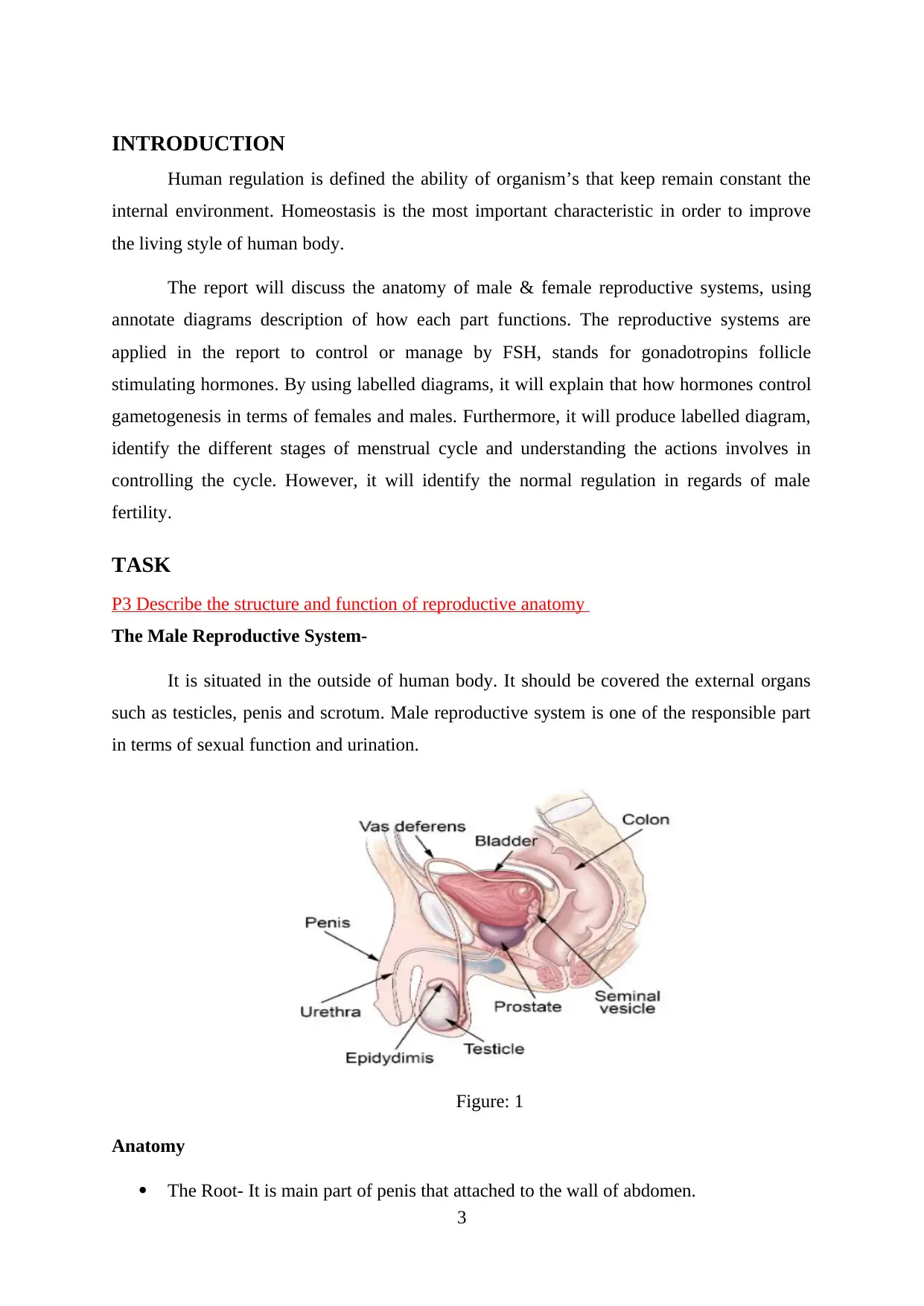
INTRODUCTION
Human regulation is defined the ability of organism’s that keep remain constant the
internal environment. Homeostasis is the most important characteristic in order to improve
the living style of human body.
The report will discuss the anatomy of male & female reproductive systems, using
annotate diagrams description of how each part functions. The reproductive systems are
applied in the report to control or manage by FSH, stands for gonadotropins follicle
stimulating hormones. By using labelled diagrams, it will explain that how hormones control
gametogenesis in terms of females and males. Furthermore, it will produce labelled diagram,
identify the different stages of menstrual cycle and understanding the actions involves in
controlling the cycle. However, it will identify the normal regulation in regards of male
fertility.
TASK
P3 Describe the structure and function of reproductive anatomy
The Male Reproductive System-
It is situated in the outside of human body. It should be covered the external organs
such as testicles, penis and scrotum. Male reproductive system is one of the responsible part
in terms of sexual function and urination.
Figure: 1
Anatomy
The Root- It is main part of penis that attached to the wall of abdomen.
3
Human regulation is defined the ability of organism’s that keep remain constant the
internal environment. Homeostasis is the most important characteristic in order to improve
the living style of human body.
The report will discuss the anatomy of male & female reproductive systems, using
annotate diagrams description of how each part functions. The reproductive systems are
applied in the report to control or manage by FSH, stands for gonadotropins follicle
stimulating hormones. By using labelled diagrams, it will explain that how hormones control
gametogenesis in terms of females and males. Furthermore, it will produce labelled diagram,
identify the different stages of menstrual cycle and understanding the actions involves in
controlling the cycle. However, it will identify the normal regulation in regards of male
fertility.
TASK
P3 Describe the structure and function of reproductive anatomy
The Male Reproductive System-
It is situated in the outside of human body. It should be covered the external organs
such as testicles, penis and scrotum. Male reproductive system is one of the responsible part
in terms of sexual function and urination.
Figure: 1
Anatomy
The Root- It is main part of penis that attached to the wall of abdomen.
3
⊘ This is a preview!⊘
Do you want full access?
Subscribe today to unlock all pages.

Trusted by 1+ million students worldwide
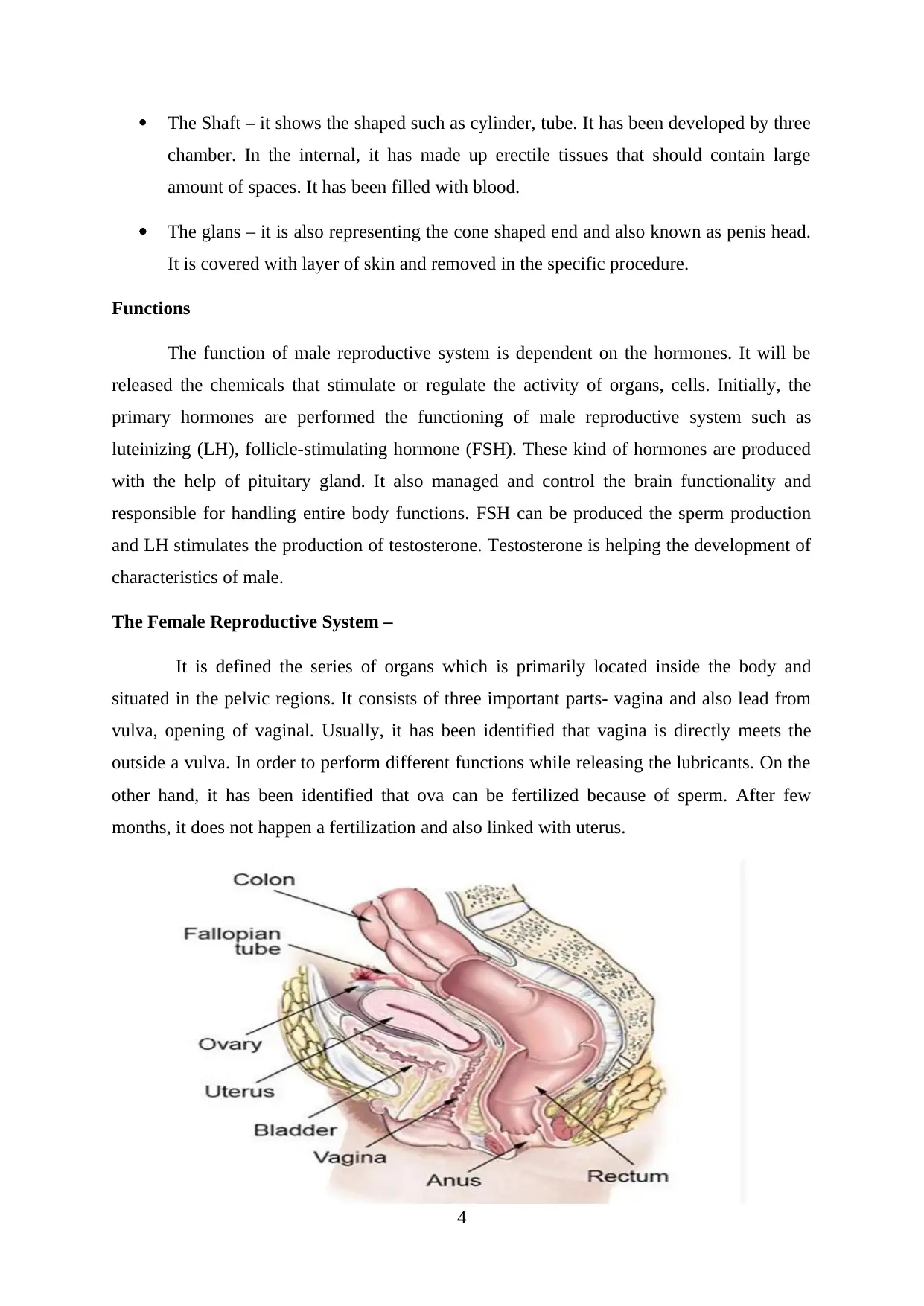
The Shaft – it shows the shaped such as cylinder, tube. It has been developed by three
chamber. In the internal, it has made up erectile tissues that should contain large
amount of spaces. It has been filled with blood.
The glans – it is also representing the cone shaped end and also known as penis head.
It is covered with layer of skin and removed in the specific procedure.
Functions
The function of male reproductive system is dependent on the hormones. It will be
released the chemicals that stimulate or regulate the activity of organs, cells. Initially, the
primary hormones are performed the functioning of male reproductive system such as
luteinizing (LH), follicle-stimulating hormone (FSH). These kind of hormones are produced
with the help of pituitary gland. It also managed and control the brain functionality and
responsible for handling entire body functions. FSH can be produced the sperm production
and LH stimulates the production of testosterone. Testosterone is helping the development of
characteristics of male.
The Female Reproductive System –
It is defined the series of organs which is primarily located inside the body and
situated in the pelvic regions. It consists of three important parts- vagina and also lead from
vulva, opening of vaginal. Usually, it has been identified that vagina is directly meets the
outside a vulva. In order to perform different functions while releasing the lubricants. On the
other hand, it has been identified that ova can be fertilized because of sperm. After few
months, it does not happen a fertilization and also linked with uterus.
4
chamber. In the internal, it has made up erectile tissues that should contain large
amount of spaces. It has been filled with blood.
The glans – it is also representing the cone shaped end and also known as penis head.
It is covered with layer of skin and removed in the specific procedure.
Functions
The function of male reproductive system is dependent on the hormones. It will be
released the chemicals that stimulate or regulate the activity of organs, cells. Initially, the
primary hormones are performed the functioning of male reproductive system such as
luteinizing (LH), follicle-stimulating hormone (FSH). These kind of hormones are produced
with the help of pituitary gland. It also managed and control the brain functionality and
responsible for handling entire body functions. FSH can be produced the sperm production
and LH stimulates the production of testosterone. Testosterone is helping the development of
characteristics of male.
The Female Reproductive System –
It is defined the series of organs which is primarily located inside the body and
situated in the pelvic regions. It consists of three important parts- vagina and also lead from
vulva, opening of vaginal. Usually, it has been identified that vagina is directly meets the
outside a vulva. In order to perform different functions while releasing the lubricants. On the
other hand, it has been identified that ova can be fertilized because of sperm. After few
months, it does not happen a fertilization and also linked with uterus.
4
Paraphrase This Document
Need a fresh take? Get an instant paraphrase of this document with our AI Paraphraser
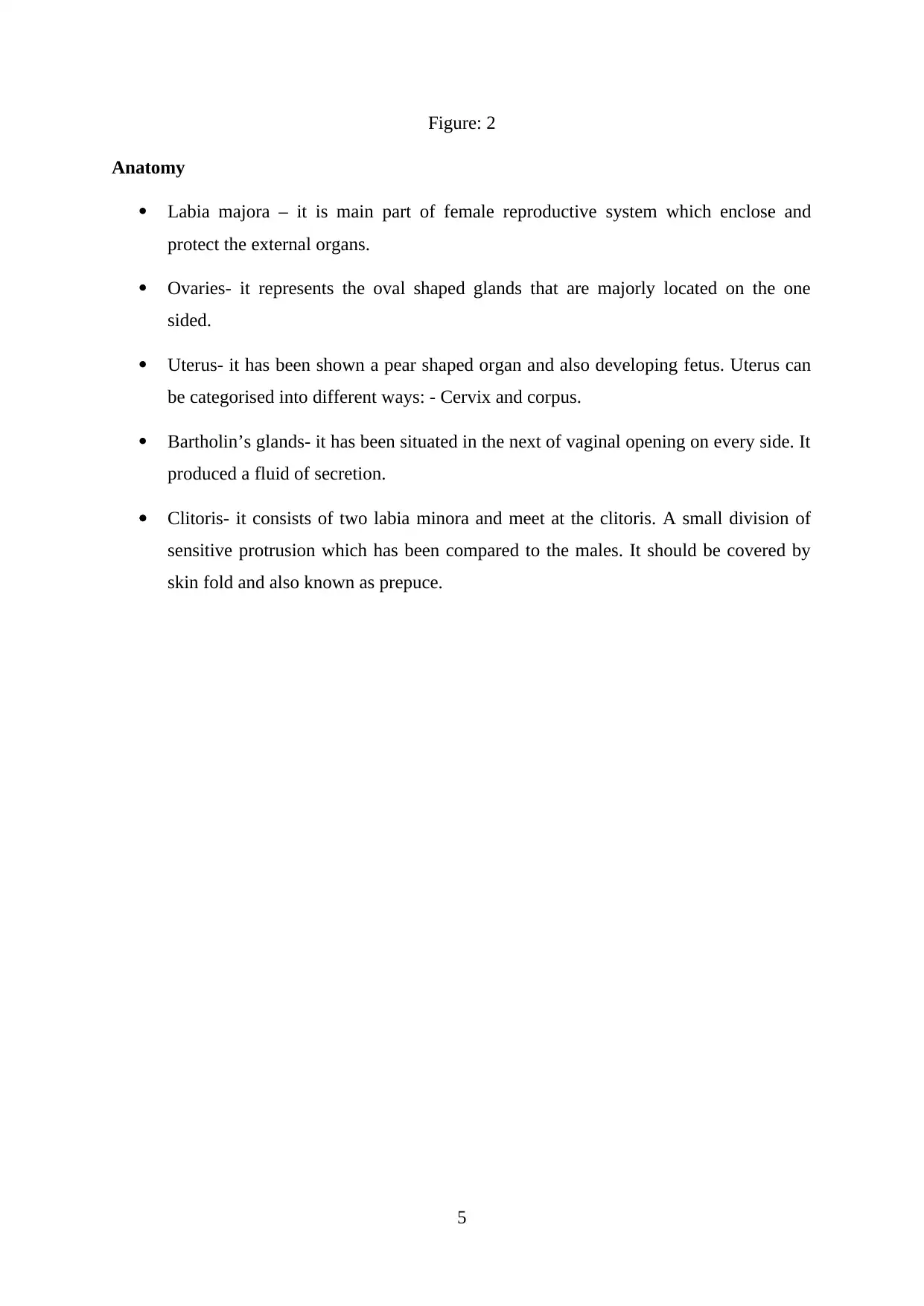
Figure: 2
Anatomy
Labia majora – it is main part of female reproductive system which enclose and
protect the external organs.
Ovaries- it represents the oval shaped glands that are majorly located on the one
sided.
Uterus- it has been shown a pear shaped organ and also developing fetus. Uterus can
be categorised into different ways: - Cervix and corpus.
Bartholin’s glands- it has been situated in the next of vaginal opening on every side. It
produced a fluid of secretion.
Clitoris- it consists of two labia minora and meet at the clitoris. A small division of
sensitive protrusion which has been compared to the males. It should be covered by
skin fold and also known as prepuce.
5
Anatomy
Labia majora – it is main part of female reproductive system which enclose and
protect the external organs.
Ovaries- it represents the oval shaped glands that are majorly located on the one
sided.
Uterus- it has been shown a pear shaped organ and also developing fetus. Uterus can
be categorised into different ways: - Cervix and corpus.
Bartholin’s glands- it has been situated in the next of vaginal opening on every side. It
produced a fluid of secretion.
Clitoris- it consists of two labia minora and meet at the clitoris. A small division of
sensitive protrusion which has been compared to the males. It should be covered by
skin fold and also known as prepuce.
5
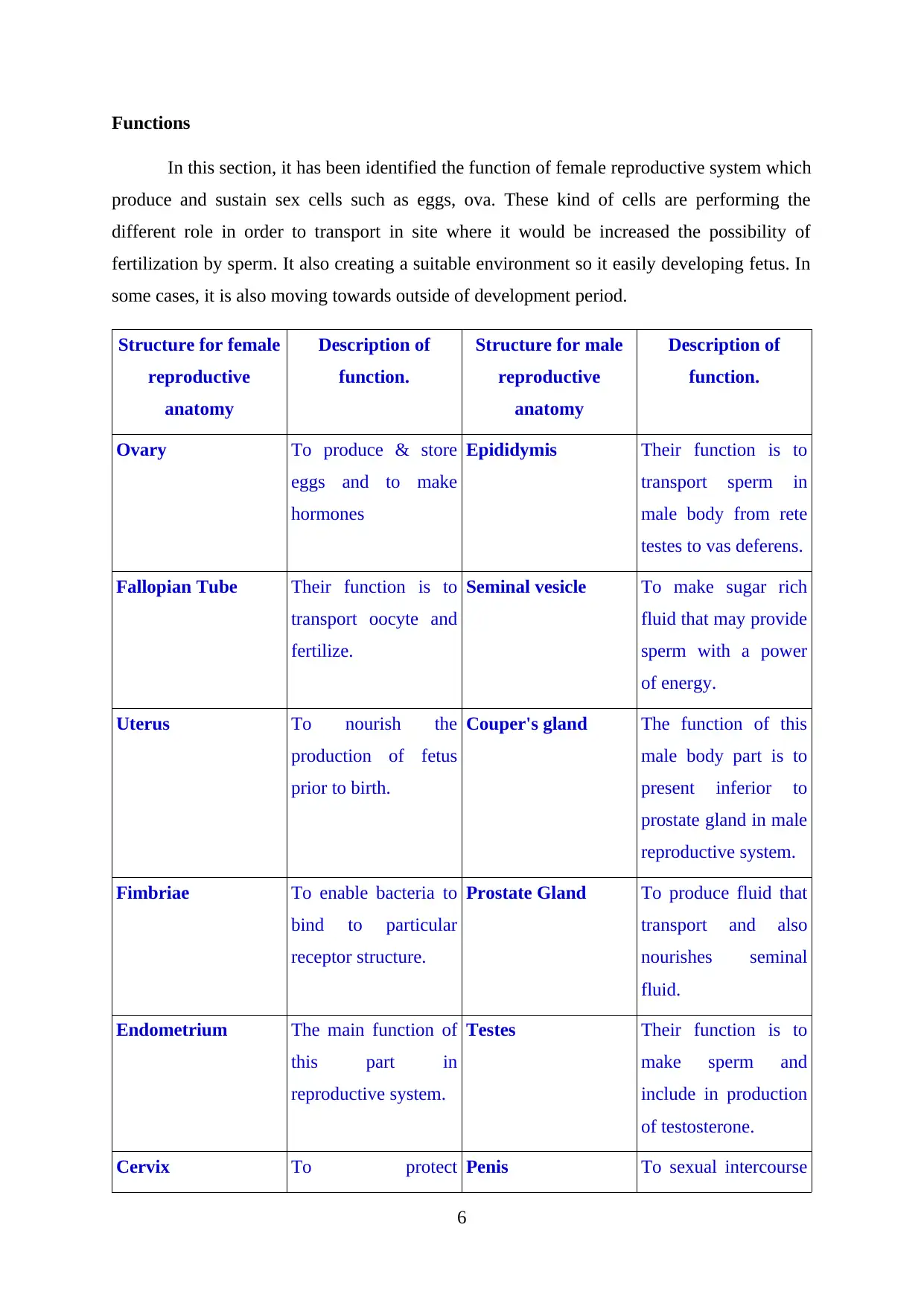
Functions
In this section, it has been identified the function of female reproductive system which
produce and sustain sex cells such as eggs, ova. These kind of cells are performing the
different role in order to transport in site where it would be increased the possibility of
fertilization by sperm. It also creating a suitable environment so it easily developing fetus. In
some cases, it is also moving towards outside of development period.
Structure for female
reproductive
anatomy
Description of
function.
Structure for male
reproductive
anatomy
Description of
function.
Ovary To produce & store
eggs and to make
hormones
Epididymis Their function is to
transport sperm in
male body from rete
testes to vas deferens.
Fallopian Tube Their function is to
transport oocyte and
fertilize.
Seminal vesicle To make sugar rich
fluid that may provide
sperm with a power
of energy.
Uterus To nourish the
production of fetus
prior to birth.
Couper's gland The function of this
male body part is to
present inferior to
prostate gland in male
reproductive system.
Fimbriae To enable bacteria to
bind to particular
receptor structure.
Prostate Gland To produce fluid that
transport and also
nourishes seminal
fluid.
Endometrium The main function of
this part in
reproductive system.
Testes Their function is to
make sperm and
include in production
of testosterone.
Cervix To protect Penis To sexual intercourse
6
In this section, it has been identified the function of female reproductive system which
produce and sustain sex cells such as eggs, ova. These kind of cells are performing the
different role in order to transport in site where it would be increased the possibility of
fertilization by sperm. It also creating a suitable environment so it easily developing fetus. In
some cases, it is also moving towards outside of development period.
Structure for female
reproductive
anatomy
Description of
function.
Structure for male
reproductive
anatomy
Description of
function.
Ovary To produce & store
eggs and to make
hormones
Epididymis Their function is to
transport sperm in
male body from rete
testes to vas deferens.
Fallopian Tube Their function is to
transport oocyte and
fertilize.
Seminal vesicle To make sugar rich
fluid that may provide
sperm with a power
of energy.
Uterus To nourish the
production of fetus
prior to birth.
Couper's gland The function of this
male body part is to
present inferior to
prostate gland in male
reproductive system.
Fimbriae To enable bacteria to
bind to particular
receptor structure.
Prostate Gland To produce fluid that
transport and also
nourishes seminal
fluid.
Endometrium The main function of
this part in
reproductive system.
Testes Their function is to
make sperm and
include in production
of testosterone.
Cervix To protect Penis To sexual intercourse
6
⊘ This is a preview!⊘
Do you want full access?
Subscribe today to unlock all pages.

Trusted by 1+ million students worldwide
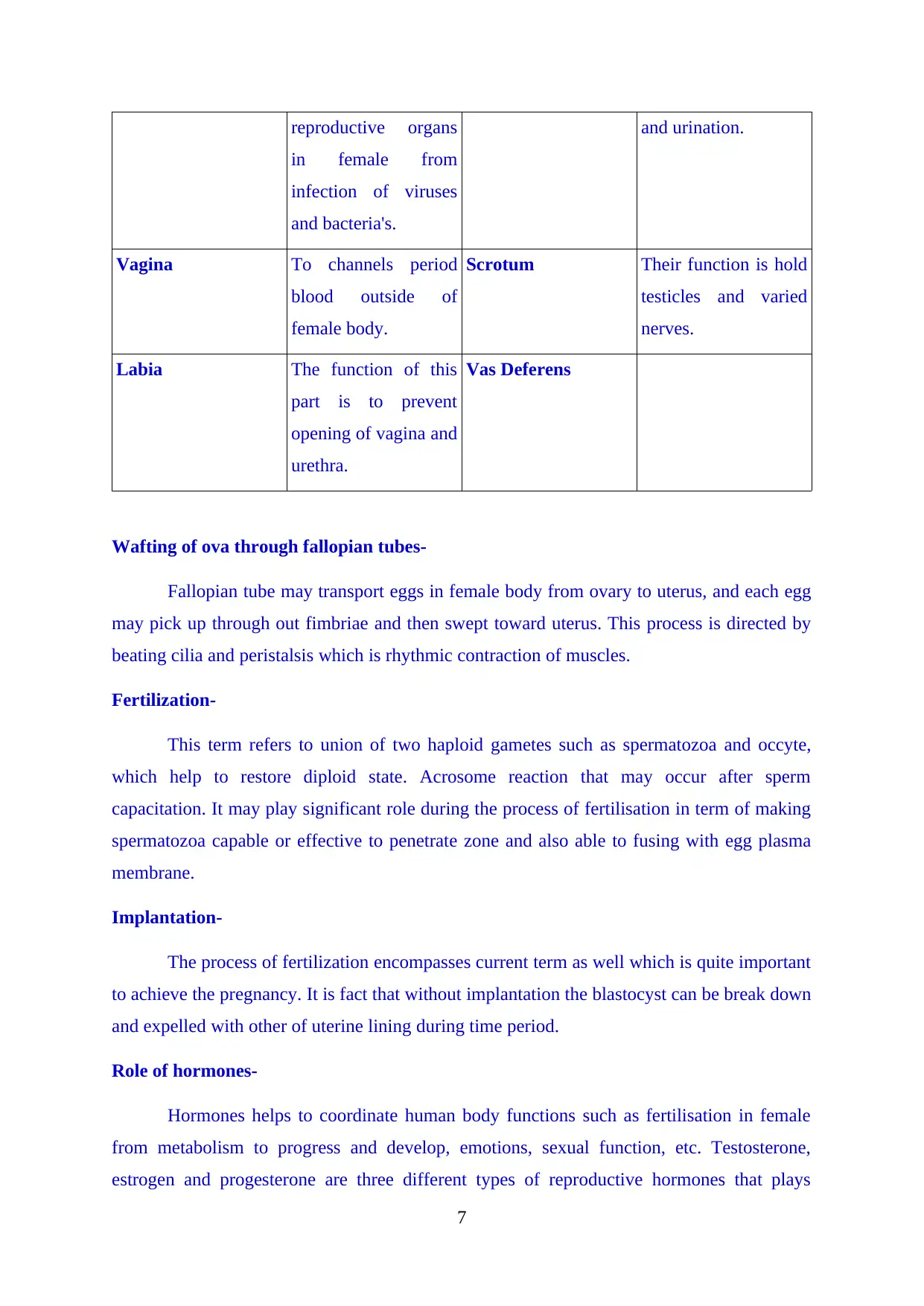
reproductive organs
in female from
infection of viruses
and bacteria's.
and urination.
Vagina To channels period
blood outside of
female body.
Scrotum Their function is hold
testicles and varied
nerves.
Labia The function of this
part is to prevent
opening of vagina and
urethra.
Vas Deferens
Wafting of ova through fallopian tubes-
Fallopian tube may transport eggs in female body from ovary to uterus, and each egg
may pick up through out fimbriae and then swept toward uterus. This process is directed by
beating cilia and peristalsis which is rhythmic contraction of muscles.
Fertilization-
This term refers to union of two haploid gametes such as spermatozoa and occyte,
which help to restore diploid state. Acrosome reaction that may occur after sperm
capacitation. It may play significant role during the process of fertilisation in term of making
spermatozoa capable or effective to penetrate zone and also able to fusing with egg plasma
membrane.
Implantation-
The process of fertilization encompasses current term as well which is quite important
to achieve the pregnancy. It is fact that without implantation the blastocyst can be break down
and expelled with other of uterine lining during time period.
Role of hormones-
Hormones helps to coordinate human body functions such as fertilisation in female
from metabolism to progress and develop, emotions, sexual function, etc. Testosterone,
estrogen and progesterone are three different types of reproductive hormones that plays
7
in female from
infection of viruses
and bacteria's.
and urination.
Vagina To channels period
blood outside of
female body.
Scrotum Their function is hold
testicles and varied
nerves.
Labia The function of this
part is to prevent
opening of vagina and
urethra.
Vas Deferens
Wafting of ova through fallopian tubes-
Fallopian tube may transport eggs in female body from ovary to uterus, and each egg
may pick up through out fimbriae and then swept toward uterus. This process is directed by
beating cilia and peristalsis which is rhythmic contraction of muscles.
Fertilization-
This term refers to union of two haploid gametes such as spermatozoa and occyte,
which help to restore diploid state. Acrosome reaction that may occur after sperm
capacitation. It may play significant role during the process of fertilisation in term of making
spermatozoa capable or effective to penetrate zone and also able to fusing with egg plasma
membrane.
Implantation-
The process of fertilization encompasses current term as well which is quite important
to achieve the pregnancy. It is fact that without implantation the blastocyst can be break down
and expelled with other of uterine lining during time period.
Role of hormones-
Hormones helps to coordinate human body functions such as fertilisation in female
from metabolism to progress and develop, emotions, sexual function, etc. Testosterone,
estrogen and progesterone are three different types of reproductive hormones that plays
7
Paraphrase This Document
Need a fresh take? Get an instant paraphrase of this document with our AI Paraphraser
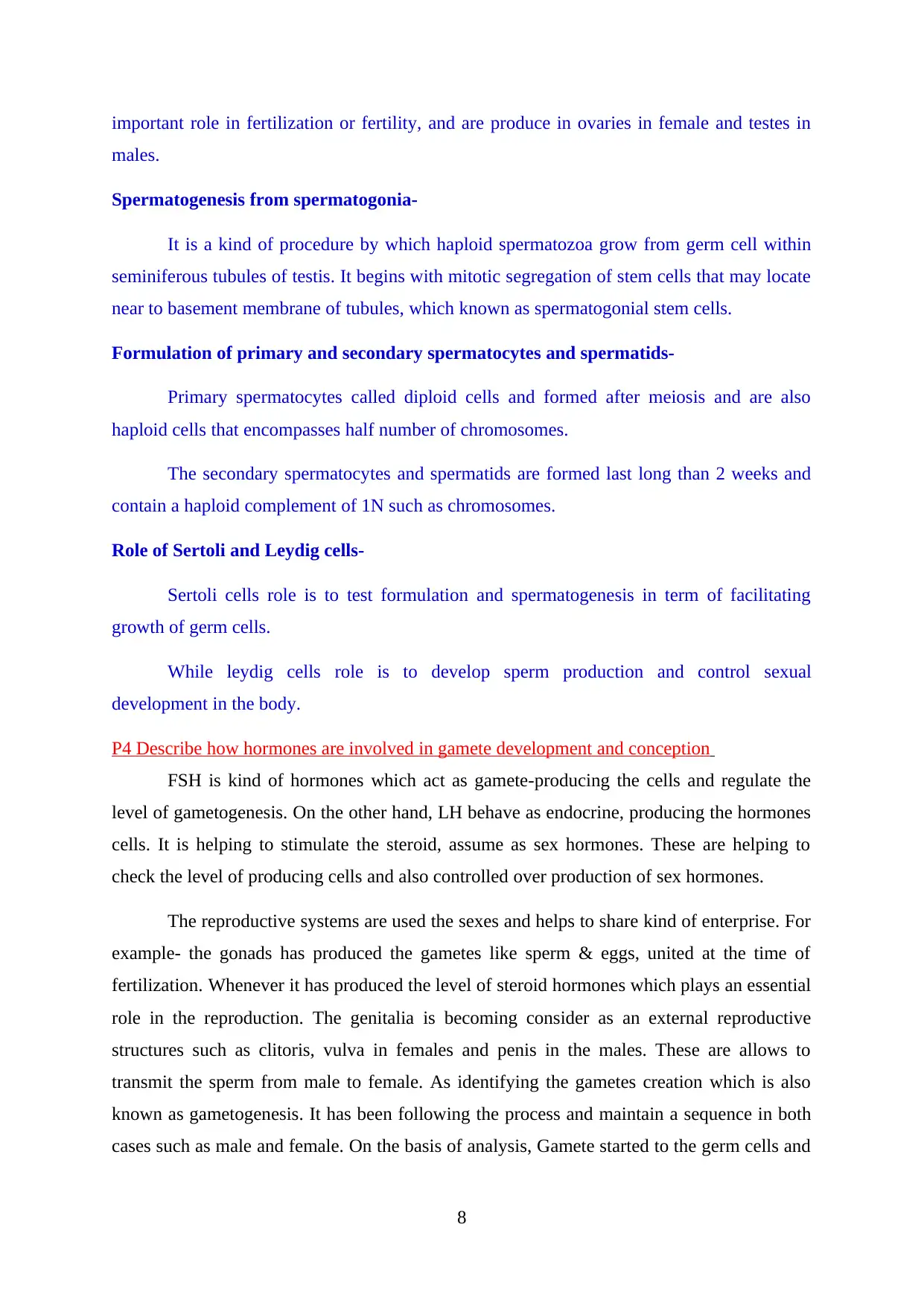
important role in fertilization or fertility, and are produce in ovaries in female and testes in
males.
Spermatogenesis from spermatogonia-
It is a kind of procedure by which haploid spermatozoa grow from germ cell within
seminiferous tubules of testis. It begins with mitotic segregation of stem cells that may locate
near to basement membrane of tubules, which known as spermatogonial stem cells.
Formulation of primary and secondary spermatocytes and spermatids-
Primary spermatocytes called diploid cells and formed after meiosis and are also
haploid cells that encompasses half number of chromosomes.
The secondary spermatocytes and spermatids are formed last long than 2 weeks and
contain a haploid complement of 1N such as chromosomes.
Role of Sertoli and Leydig cells-
Sertoli cells role is to test formulation and spermatogenesis in term of facilitating
growth of germ cells.
While leydig cells role is to develop sperm production and control sexual
development in the body.
P4 Describe how hormones are involved in gamete development and conception
FSH is kind of hormones which act as gamete-producing the cells and regulate the
level of gametogenesis. On the other hand, LH behave as endocrine, producing the hormones
cells. It is helping to stimulate the steroid, assume as sex hormones. These are helping to
check the level of producing cells and also controlled over production of sex hormones.
The reproductive systems are used the sexes and helps to share kind of enterprise. For
example- the gonads has produced the gametes like sperm & eggs, united at the time of
fertilization. Whenever it has produced the level of steroid hormones which plays an essential
role in the reproduction. The genitalia is becoming consider as an external reproductive
structures such as clitoris, vulva in females and penis in the males. These are allows to
transmit the sperm from male to female. As identifying the gametes creation which is also
known as gametogenesis. It has been following the process and maintain a sequence in both
cases such as male and female. On the basis of analysis, Gamete started to the germ cells and
8
males.
Spermatogenesis from spermatogonia-
It is a kind of procedure by which haploid spermatozoa grow from germ cell within
seminiferous tubules of testis. It begins with mitotic segregation of stem cells that may locate
near to basement membrane of tubules, which known as spermatogonial stem cells.
Formulation of primary and secondary spermatocytes and spermatids-
Primary spermatocytes called diploid cells and formed after meiosis and are also
haploid cells that encompasses half number of chromosomes.
The secondary spermatocytes and spermatids are formed last long than 2 weeks and
contain a haploid complement of 1N such as chromosomes.
Role of Sertoli and Leydig cells-
Sertoli cells role is to test formulation and spermatogenesis in term of facilitating
growth of germ cells.
While leydig cells role is to develop sperm production and control sexual
development in the body.
P4 Describe how hormones are involved in gamete development and conception
FSH is kind of hormones which act as gamete-producing the cells and regulate the
level of gametogenesis. On the other hand, LH behave as endocrine, producing the hormones
cells. It is helping to stimulate the steroid, assume as sex hormones. These are helping to
check the level of producing cells and also controlled over production of sex hormones.
The reproductive systems are used the sexes and helps to share kind of enterprise. For
example- the gonads has produced the gametes like sperm & eggs, united at the time of
fertilization. Whenever it has produced the level of steroid hormones which plays an essential
role in the reproduction. The genitalia is becoming consider as an external reproductive
structures such as clitoris, vulva in females and penis in the males. These are allows to
transmit the sperm from male to female. As identifying the gametes creation which is also
known as gametogenesis. It has been following the process and maintain a sequence in both
cases such as male and female. On the basis of analysis, Gamete started to the germ cells and
8
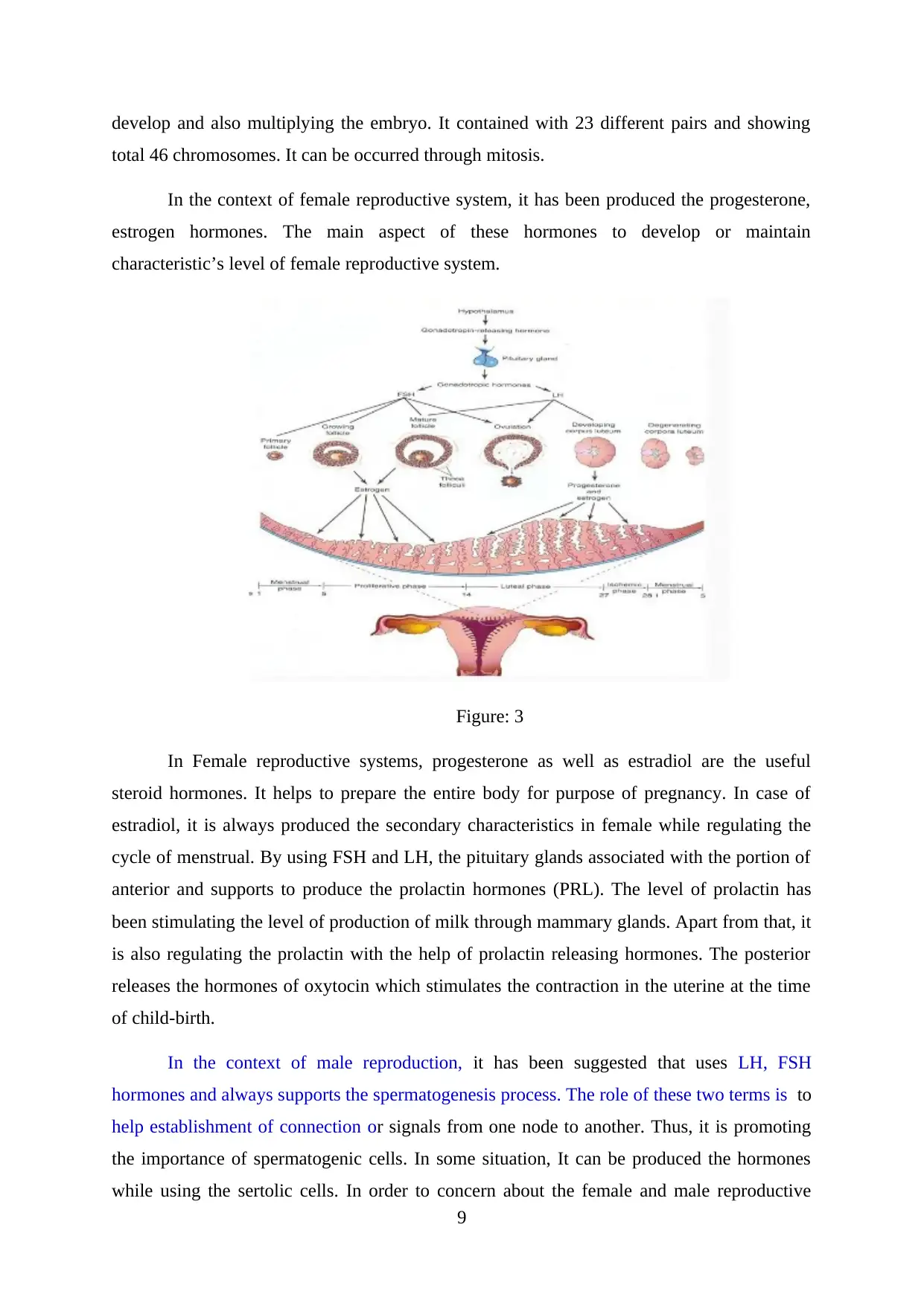
develop and also multiplying the embryo. It contained with 23 different pairs and showing
total 46 chromosomes. It can be occurred through mitosis.
In the context of female reproductive system, it has been produced the progesterone,
estrogen hormones. The main aspect of these hormones to develop or maintain
characteristic’s level of female reproductive system.
Figure: 3
In Female reproductive systems, progesterone as well as estradiol are the useful
steroid hormones. It helps to prepare the entire body for purpose of pregnancy. In case of
estradiol, it is always produced the secondary characteristics in female while regulating the
cycle of menstrual. By using FSH and LH, the pituitary glands associated with the portion of
anterior and supports to produce the prolactin hormones (PRL). The level of prolactin has
been stimulating the level of production of milk through mammary glands. Apart from that, it
is also regulating the prolactin with the help of prolactin releasing hormones. The posterior
releases the hormones of oxytocin which stimulates the contraction in the uterine at the time
of child-birth.
In the context of male reproduction, it has been suggested that uses LH, FSH
hormones and always supports the spermatogenesis process. The role of these two terms is to
help establishment of connection or signals from one node to another. Thus, it is promoting
the importance of spermatogenic cells. In some situation, It can be produced the hormones
while using the sertolic cells. In order to concern about the female and male reproductive
9
total 46 chromosomes. It can be occurred through mitosis.
In the context of female reproductive system, it has been produced the progesterone,
estrogen hormones. The main aspect of these hormones to develop or maintain
characteristic’s level of female reproductive system.
Figure: 3
In Female reproductive systems, progesterone as well as estradiol are the useful
steroid hormones. It helps to prepare the entire body for purpose of pregnancy. In case of
estradiol, it is always produced the secondary characteristics in female while regulating the
cycle of menstrual. By using FSH and LH, the pituitary glands associated with the portion of
anterior and supports to produce the prolactin hormones (PRL). The level of prolactin has
been stimulating the level of production of milk through mammary glands. Apart from that, it
is also regulating the prolactin with the help of prolactin releasing hormones. The posterior
releases the hormones of oxytocin which stimulates the contraction in the uterine at the time
of child-birth.
In the context of male reproduction, it has been suggested that uses LH, FSH
hormones and always supports the spermatogenesis process. The role of these two terms is to
help establishment of connection or signals from one node to another. Thus, it is promoting
the importance of spermatogenic cells. In some situation, It can be produced the hormones
while using the sertolic cells. In order to concern about the female and male reproductive
9
⊘ This is a preview!⊘
Do you want full access?
Subscribe today to unlock all pages.

Trusted by 1+ million students worldwide
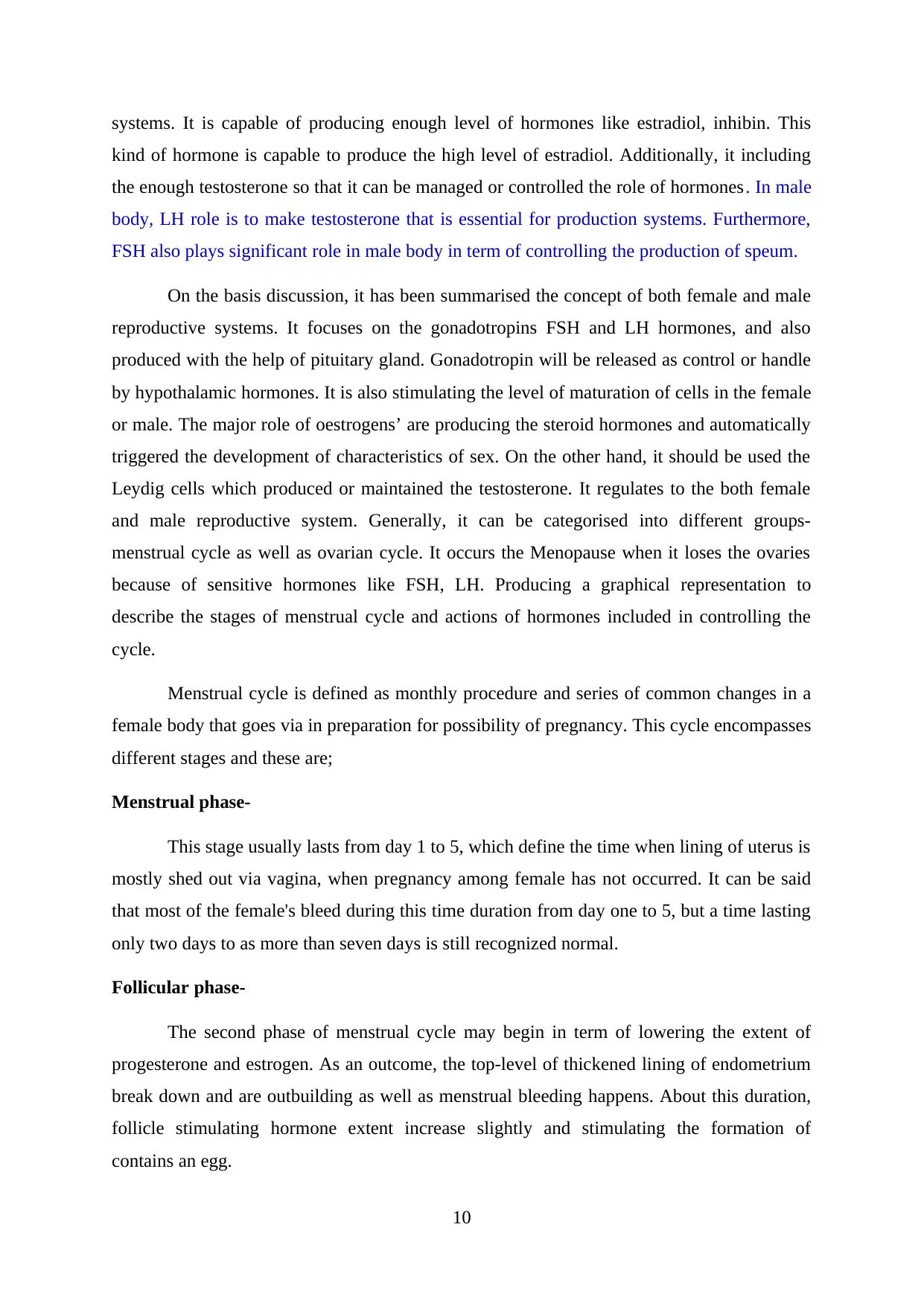
systems. It is capable of producing enough level of hormones like estradiol, inhibin. This
kind of hormone is capable to produce the high level of estradiol. Additionally, it including
the enough testosterone so that it can be managed or controlled the role of hormones. In male
body, LH role is to make testosterone that is essential for production systems. Furthermore,
FSH also plays significant role in male body in term of controlling the production of speum.
On the basis discussion, it has been summarised the concept of both female and male
reproductive systems. It focuses on the gonadotropins FSH and LH hormones, and also
produced with the help of pituitary gland. Gonadotropin will be released as control or handle
by hypothalamic hormones. It is also stimulating the level of maturation of cells in the female
or male. The major role of oestrogens’ are producing the steroid hormones and automatically
triggered the development of characteristics of sex. On the other hand, it should be used the
Leydig cells which produced or maintained the testosterone. It regulates to the both female
and male reproductive system. Generally, it can be categorised into different groups-
menstrual cycle as well as ovarian cycle. It occurs the Menopause when it loses the ovaries
because of sensitive hormones like FSH, LH. Producing a graphical representation to
describe the stages of menstrual cycle and actions of hormones included in controlling the
cycle.
Menstrual cycle is defined as monthly procedure and series of common changes in a
female body that goes via in preparation for possibility of pregnancy. This cycle encompasses
different stages and these are;
Menstrual phase-
This stage usually lasts from day 1 to 5, which define the time when lining of uterus is
mostly shed out via vagina, when pregnancy among female has not occurred. It can be said
that most of the female's bleed during this time duration from day one to 5, but a time lasting
only two days to as more than seven days is still recognized normal.
Follicular phase-
The second phase of menstrual cycle may begin in term of lowering the extent of
progesterone and estrogen. As an outcome, the top-level of thickened lining of endometrium
break down and are outbuilding as well as menstrual bleeding happens. About this duration,
follicle stimulating hormone extent increase slightly and stimulating the formation of
contains an egg.
10
kind of hormone is capable to produce the high level of estradiol. Additionally, it including
the enough testosterone so that it can be managed or controlled the role of hormones. In male
body, LH role is to make testosterone that is essential for production systems. Furthermore,
FSH also plays significant role in male body in term of controlling the production of speum.
On the basis discussion, it has been summarised the concept of both female and male
reproductive systems. It focuses on the gonadotropins FSH and LH hormones, and also
produced with the help of pituitary gland. Gonadotropin will be released as control or handle
by hypothalamic hormones. It is also stimulating the level of maturation of cells in the female
or male. The major role of oestrogens’ are producing the steroid hormones and automatically
triggered the development of characteristics of sex. On the other hand, it should be used the
Leydig cells which produced or maintained the testosterone. It regulates to the both female
and male reproductive system. Generally, it can be categorised into different groups-
menstrual cycle as well as ovarian cycle. It occurs the Menopause when it loses the ovaries
because of sensitive hormones like FSH, LH. Producing a graphical representation to
describe the stages of menstrual cycle and actions of hormones included in controlling the
cycle.
Menstrual cycle is defined as monthly procedure and series of common changes in a
female body that goes via in preparation for possibility of pregnancy. This cycle encompasses
different stages and these are;
Menstrual phase-
This stage usually lasts from day 1 to 5, which define the time when lining of uterus is
mostly shed out via vagina, when pregnancy among female has not occurred. It can be said
that most of the female's bleed during this time duration from day one to 5, but a time lasting
only two days to as more than seven days is still recognized normal.
Follicular phase-
The second phase of menstrual cycle may begin in term of lowering the extent of
progesterone and estrogen. As an outcome, the top-level of thickened lining of endometrium
break down and are outbuilding as well as menstrual bleeding happens. About this duration,
follicle stimulating hormone extent increase slightly and stimulating the formation of
contains an egg.
10
Paraphrase This Document
Need a fresh take? Get an instant paraphrase of this document with our AI Paraphraser
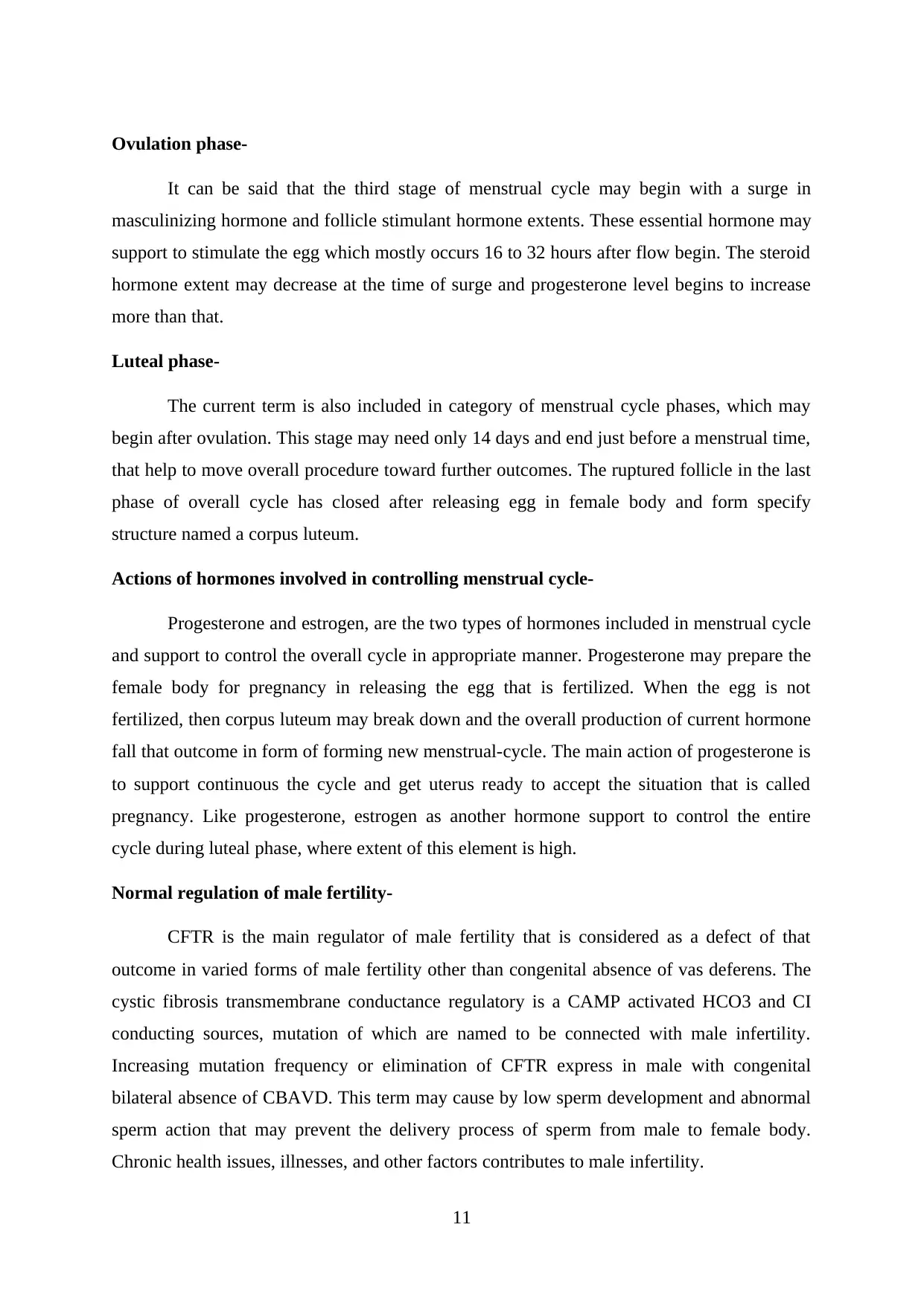
Ovulation phase-
It can be said that the third stage of menstrual cycle may begin with a surge in
masculinizing hormone and follicle stimulant hormone extents. These essential hormone may
support to stimulate the egg which mostly occurs 16 to 32 hours after flow begin. The steroid
hormone extent may decrease at the time of surge and progesterone level begins to increase
more than that.
Luteal phase-
The current term is also included in category of menstrual cycle phases, which may
begin after ovulation. This stage may need only 14 days and end just before a menstrual time,
that help to move overall procedure toward further outcomes. The ruptured follicle in the last
phase of overall cycle has closed after releasing egg in female body and form specify
structure named a corpus luteum.
Actions of hormones involved in controlling menstrual cycle-
Progesterone and estrogen, are the two types of hormones included in menstrual cycle
and support to control the overall cycle in appropriate manner. Progesterone may prepare the
female body for pregnancy in releasing the egg that is fertilized. When the egg is not
fertilized, then corpus luteum may break down and the overall production of current hormone
fall that outcome in form of forming new menstrual-cycle. The main action of progesterone is
to support continuous the cycle and get uterus ready to accept the situation that is called
pregnancy. Like progesterone, estrogen as another hormone support to control the entire
cycle during luteal phase, where extent of this element is high.
Normal regulation of male fertility-
CFTR is the main regulator of male fertility that is considered as a defect of that
outcome in varied forms of male fertility other than congenital absence of vas deferens. The
cystic fibrosis transmembrane conductance regulatory is a CAMP activated HCO3 and CI
conducting sources, mutation of which are named to be connected with male infertility.
Increasing mutation frequency or elimination of CFTR express in male with congenital
bilateral absence of CBAVD. This term may cause by low sperm development and abnormal
sperm action that may prevent the delivery process of sperm from male to female body.
Chronic health issues, illnesses, and other factors contributes to male infertility.
11
It can be said that the third stage of menstrual cycle may begin with a surge in
masculinizing hormone and follicle stimulant hormone extents. These essential hormone may
support to stimulate the egg which mostly occurs 16 to 32 hours after flow begin. The steroid
hormone extent may decrease at the time of surge and progesterone level begins to increase
more than that.
Luteal phase-
The current term is also included in category of menstrual cycle phases, which may
begin after ovulation. This stage may need only 14 days and end just before a menstrual time,
that help to move overall procedure toward further outcomes. The ruptured follicle in the last
phase of overall cycle has closed after releasing egg in female body and form specify
structure named a corpus luteum.
Actions of hormones involved in controlling menstrual cycle-
Progesterone and estrogen, are the two types of hormones included in menstrual cycle
and support to control the overall cycle in appropriate manner. Progesterone may prepare the
female body for pregnancy in releasing the egg that is fertilized. When the egg is not
fertilized, then corpus luteum may break down and the overall production of current hormone
fall that outcome in form of forming new menstrual-cycle. The main action of progesterone is
to support continuous the cycle and get uterus ready to accept the situation that is called
pregnancy. Like progesterone, estrogen as another hormone support to control the entire
cycle during luteal phase, where extent of this element is high.
Normal regulation of male fertility-
CFTR is the main regulator of male fertility that is considered as a defect of that
outcome in varied forms of male fertility other than congenital absence of vas deferens. The
cystic fibrosis transmembrane conductance regulatory is a CAMP activated HCO3 and CI
conducting sources, mutation of which are named to be connected with male infertility.
Increasing mutation frequency or elimination of CFTR express in male with congenital
bilateral absence of CBAVD. This term may cause by low sperm development and abnormal
sperm action that may prevent the delivery process of sperm from male to female body.
Chronic health issues, illnesses, and other factors contributes to male infertility.
11
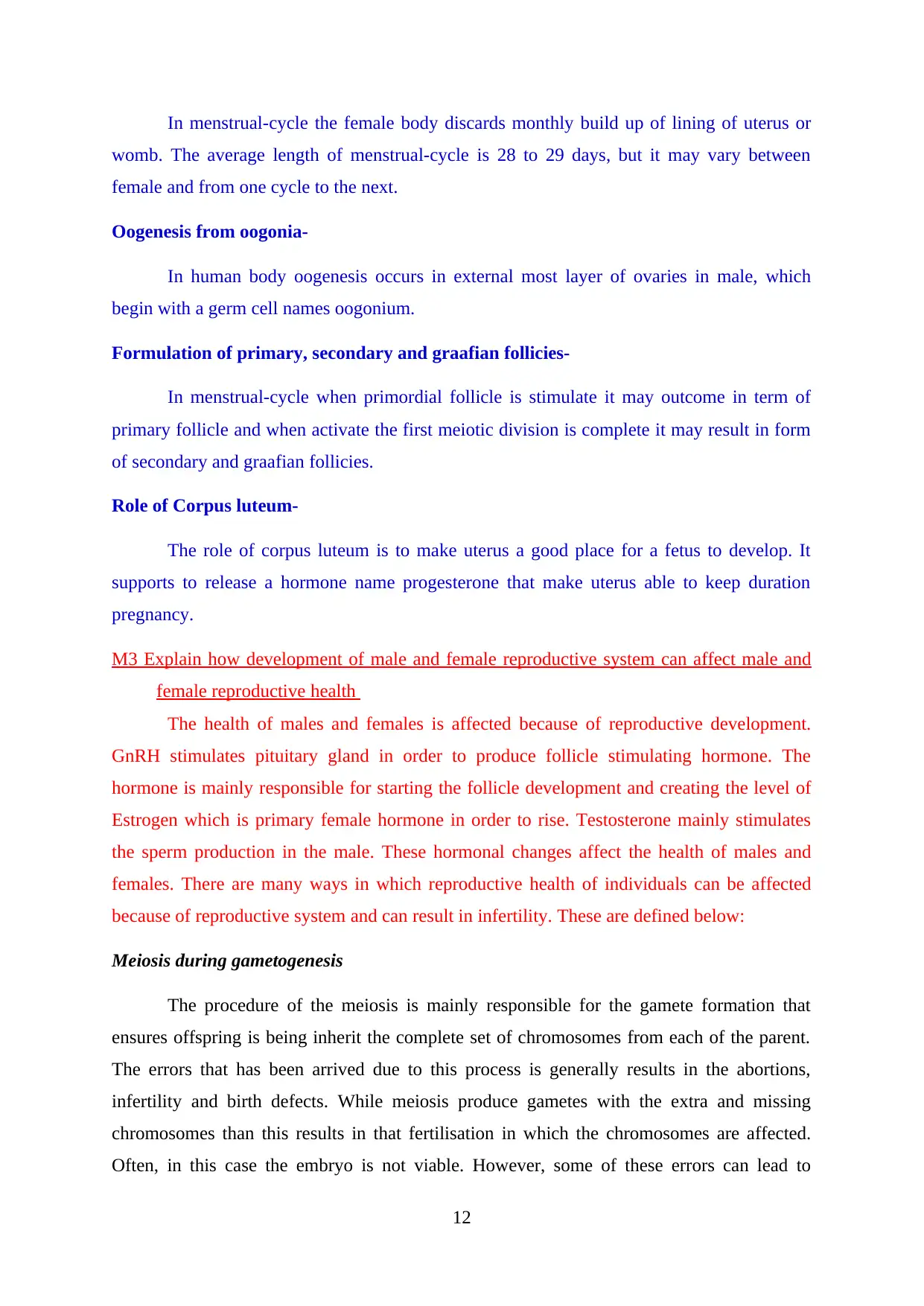
In menstrual-cycle the female body discards monthly build up of lining of uterus or
womb. The average length of menstrual-cycle is 28 to 29 days, but it may vary between
female and from one cycle to the next.
Oogenesis from oogonia-
In human body oogenesis occurs in external most layer of ovaries in male, which
begin with a germ cell names oogonium.
Formulation of primary, secondary and graafian follicies-
In menstrual-cycle when primordial follicle is stimulate it may outcome in term of
primary follicle and when activate the first meiotic division is complete it may result in form
of secondary and graafian follicies.
Role of Corpus luteum-
The role of corpus luteum is to make uterus a good place for a fetus to develop. It
supports to release a hormone name progesterone that make uterus able to keep duration
pregnancy.
M3 Explain how development of male and female reproductive system can affect male and
female reproductive health
The health of males and females is affected because of reproductive development.
GnRH stimulates pituitary gland in order to produce follicle stimulating hormone. The
hormone is mainly responsible for starting the follicle development and creating the level of
Estrogen which is primary female hormone in order to rise. Testosterone mainly stimulates
the sperm production in the male. These hormonal changes affect the health of males and
females. There are many ways in which reproductive health of individuals can be affected
because of reproductive system and can result in infertility. These are defined below:
Meiosis during gametogenesis
The procedure of the meiosis is mainly responsible for the gamete formation that
ensures offspring is being inherit the complete set of chromosomes from each of the parent.
The errors that has been arrived due to this process is generally results in the abortions,
infertility and birth defects. While meiosis produce gametes with the extra and missing
chromosomes than this results in that fertilisation in which the chromosomes are affected.
Often, in this case the embryo is not viable. However, some of these errors can lead to
12
womb. The average length of menstrual-cycle is 28 to 29 days, but it may vary between
female and from one cycle to the next.
Oogenesis from oogonia-
In human body oogenesis occurs in external most layer of ovaries in male, which
begin with a germ cell names oogonium.
Formulation of primary, secondary and graafian follicies-
In menstrual-cycle when primordial follicle is stimulate it may outcome in term of
primary follicle and when activate the first meiotic division is complete it may result in form
of secondary and graafian follicies.
Role of Corpus luteum-
The role of corpus luteum is to make uterus a good place for a fetus to develop. It
supports to release a hormone name progesterone that make uterus able to keep duration
pregnancy.
M3 Explain how development of male and female reproductive system can affect male and
female reproductive health
The health of males and females is affected because of reproductive development.
GnRH stimulates pituitary gland in order to produce follicle stimulating hormone. The
hormone is mainly responsible for starting the follicle development and creating the level of
Estrogen which is primary female hormone in order to rise. Testosterone mainly stimulates
the sperm production in the male. These hormonal changes affect the health of males and
females. There are many ways in which reproductive health of individuals can be affected
because of reproductive system and can result in infertility. These are defined below:
Meiosis during gametogenesis
The procedure of the meiosis is mainly responsible for the gamete formation that
ensures offspring is being inherit the complete set of chromosomes from each of the parent.
The errors that has been arrived due to this process is generally results in the abortions,
infertility and birth defects. While meiosis produce gametes with the extra and missing
chromosomes than this results in that fertilisation in which the chromosomes are affected.
Often, in this case the embryo is not viable. However, some of these errors can lead to
12
⊘ This is a preview!⊘
Do you want full access?
Subscribe today to unlock all pages.

Trusted by 1+ million students worldwide
1 out of 15
Related Documents
Your All-in-One AI-Powered Toolkit for Academic Success.
+13062052269
info@desklib.com
Available 24*7 on WhatsApp / Email
![[object Object]](/_next/static/media/star-bottom.7253800d.svg)
Unlock your academic potential
Copyright © 2020–2025 A2Z Services. All Rights Reserved. Developed and managed by ZUCOL.




